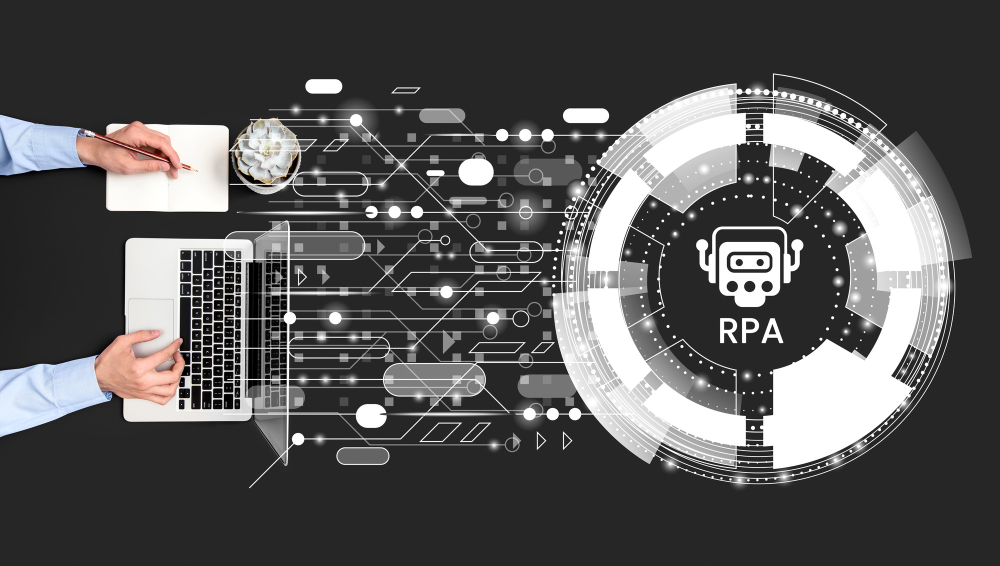As the next major revolution in digital transformation, RPA has the potential to help organizations shift from being manpower-driven to technology-centric while achieving significant results. RPA employs software robots to carry out tasks that follow rules. There are two types of RPA: attended and unattended. Both automate tasks, although they do it in slightly different ways. Attended bots require staff activation, whereas unattended bots run on a predetermined schedule without human input. This is the main distinction between attended and unattended RPA. In this blog, we will discuss the benefits of Unattended Robotic Process Automation for business efficiency. For that let’s first explore the idea of unattended RPA in detail.
What is an Unattended RPA?
Unattended RPA bots carry out tasks and communicate with users of various apps without human oversight. These bots can work on a pre-defined timetable or can be initiated by occurrences with a predetermined set of rules. Unattended bots perform autonomously in the background and undertake sophisticated jobs and processes. These bots also interface with humans for confirmation, to ask a question, or alert when there is an issue.
How Unattended RPA Works?
These don’t need human involvement and operate remotely on servers for process automation. Their greatest relevance is in back-office functions. The main advantages are raised output, precision, and compliance. Additionally, the staff can be freed from tedious, repetitive duties so they can focus more on essential demands. RPA is a simple technology to combine with any of your current processes. Many business processes are built to be fully automated, allowing a bot to complete an entire procedure all by itself. These bots are frequently started by an established timetable or criteria in the process flow, like an email. They then perform a procedure that is guided by regulations. Both monitored and uncontrolled bots can work together as part of a broader RPA solution. Unattended bots will be in operation when a batch of new customer data is received in a spreadsheet that requires to be submitted into several programs. An unattended bot could effortlessly process this data. Since they are available 24/7, they’re ideal for industries like telecommunications, healthcare, and the hospitality industry, among others. The bot can perform the precise tasks for which it was developed without the help or involvement of humans due to its automation. Simply put, they are willing to act in total freedom while upholding the established conventions.
How Can RPA Help Enterprises?
A company can save money, increase productivity, reduce errors, and boost overall efficiency by automating jobs with RPA and directing their employees toward crucial tasks that need intellectual ability. According to reports, RPA can speed up business process execution by 5 to 10 times while using 37% fewer resources. RPA has developed significantly since it initially appeared in the emerging technology market and is now capable of carrying out a wide range of activities.
- Self-triggered and capable of operation without the need for human interaction.
- Real-time alterations to functions
- Operation deployment, scheduling, and auditing
- Effective data collection, sorting, and analysis lowers operating costs
- Eliminates mistakes
- Operates on personal computers, private servers, and cloud
Benefits Of Unattended Robotic Process Automation
Businesses can scale swiftly and stay up with changing client expectations with the help of unattended RPA bots. In order to handle duties like maintaining inventory, processing orders, receiving payments, etc., businesses can hire less staff. Here are a few more noteworthy benefits of unsupervised bots.
1. It encourages easier task completion.
unattended bots allow for “set and forget” operation, however, administrators have complete control over their actions. As a result, staff members can be free to concentrate on higher-value tasks while repetitive tasks happen all throughout the span of the background while they work. When necessary, employees can concurrently verify the status. For industries like healthcare, hotels, and telecommunications that demand continuous, accurate work and 24/7 operations, unattended bots can be extremely beneficial. Operators can examine, analyze, and implement scheduling, reporting, accounting, tracking, and modification operations in real time within a centralized hub, and unattended automation can be performed remotely through a number of interfaces or platforms. Employees are therefore better able to collaborate and communicate within an automation platform, which can aid in the removal of functional and communication silos across organizations.
2. Client satisfaction
Your customer care staff will have more time for attentive customer service if they are not occupied with forms and calculations. As a result, customers have a better overall experience with the implementation of RPA, and it is much easier to achieve service-level agreements’ demands. Customer needs are difficult to meet. Just one incident is enough to shatter their trust in you and drive them toward your competition. On top of that, consumer needs tend to shift over time, making it tougher for you to satisfy them. But when tedious, repetitive duties are delegated to bots, your staff will have more time on their hands to attend to consumer concerns. To solve issues that cannot be resolved by automation, you require knowledgeable customer support agents. Additionally, RPA had an effect on the company in terms of customer service. In order to better understand and serve the needs of your customers, RPA can help you produce automated reports to better understand and serve the needs of your customers, RPA can help you produce automated reports..
3. Enhanced Efficiency
Efficiency comes next on our list of corporate advantages provided by robotic process automation. Human productivity is constrained by the finite number of hours they may devote to each day. RPA software, however, does not require a break. It is not in need of sick days or vacations either. It is available to you 365 days a year, 24 hours a day. Overall, a single RPA robot can accomplish as many jobs as two to five full-time employees could manually. By facilitating communication and consequently effective teamwork among employees from different departments, an integrated automation platform helps to reduce the side effects of departmental and communication silos. Enterprise-level data administration and documentation are simplified using unattended RPA robots. Unattended RPA bots are mostly utilized in the back office, which is where a lot of data is acquired, arranged, and assessed. As opposed to attended bots, which are frequently used for short-term efficiency, they can be used for longer-term automation initiatives to better serve your employees, partners, and your organization. As a result, a business can reduce operating costs, increase productivity, reallocate staff skill sets away from repetitive tasks, improve compliance, and eliminate mistakes.
4. Improved Accuracy
We all make mistakes from time to time. However, when you have a company to operate, even tiny mistakes could cost you a lot of money. Not to mention how long it would take to correct those errors by hand. The positive aspect is that you may get rid of processing errors by deploying RPA in your company. Based on the Deloitte Global RPA Survey, 85% of participants say that benefits like precision, rapidity, and flexibility met or surpassed their expectations. Having said that, RPA requires extensive testing. As a result, you need to take caution while employing robotic process automation to visualize and optimize business processes. And in order to fully realize its possibilities, you will require management and training. You won’t have to be concerned about bots making mistakes that people would make.
5. Higher Security
Continuous manual effort is expected to result in periodic data leaks and breaches, whereas RPA improves data security. To boost security assurance, a well-designed and continuously operated solution should be employed. In areas with strong personal data restrictions, RPA offers the potential benefit of reducing the number of human engagements necessary by organizations for handling personal information. Facilitating this retreat and avoiding direct interaction with sensitive information will help you achieve accountability and make the application of management principles simpler.
RPA bots, as was already said, are made to carry out particular duties. We now have security as a further benefit of implementing RPA in the company as a result of this very reality. There is no chance of data leakage because Robotic Process Automation works at the level of detail. In fact, the adoption of RPA calls for a workforce that is capable of managing (and controlling) both humans and machines. Like any new technology, it generates more job opportunities than it eliminates.
6. Automated Responses & Triggers
Every RPA system typically contains planning skills, and even while these skills much exceed those of a scheduler, they yet help managers with fully and partially automated scheduling. The initial situation only reacts and triggers when a specific event takes place, typically a human action like a click. The trigger for unattended automation might be anything, such as an email or document, and does not necessarily have to be a human activity. Employing triggers and reactions, businesses can pinpoint certain aspects of their processes that could be fully or partially automated.
7. Strengthen the workforce.
Despite common assumptions, robots aren’t replacing workers; instead, they’re facilitating new career opportunities. A greater amount of work is completed and employees are satisfied when there is less strain on them. According to studies, employees are more content when they are engaged in productive tasks. A high level of motivation is a direct result of enhanced employee satisfaction; as a result, your employees are less likely to feel forced to change employment, and resignation rates are maintained to a minimum.
8. Improved analytics
RPA enables businesses to analyze data and derive valuable insights. They collect information on everything from the amount of work to cycle times that can be analyzed and used to support a number of advancements in processes by identifying different shortcomings and simplifying them to increase efficiency. Additionally, it enables a broader range of data collecting in areas where it is impractical to use humans. This frees you up to concentrate more on analyzing the facts to draw conclusions and make wiser decisions.
9. Increased Possibilities for Scalability
RPA can support a variety of business procedures to help you achieve your goals. You can change not only statistics but any type of routine tasks that your organization’s desire to grow requires. RPA makes it simple for smaller businesses to adjust to irregular market demands, leveling up the competition for them. RPA programs have scalability in mind. No professional team of humans can grow their competitive operations to the same extent as a unit of automated bots. RPA can be employed in a variety of industries and for many different functions. Automated bots can operate at a size and scope that human groups cannot. Robotic operations that are automated can be repeatedly replicated and reprogrammed to create countless active systems. Additionally, machine learning and artificial intelligence are increasingly being included in RPA solutions. This offers further scaling that falls short of human output.
Winding Up!
Robotic process automation (RPA) is being used in almost all industries. RPA has been used by businesses to automate routine front- and back-office work. RPA bots interact with a variety of software initiatives to perform operations at the user interface level without changing the already-existing programs. RPA bots function in two models: Attended and Unattended, depending on the business requirement. In this blog, we read how these unattended models perform and why you should choose to automate your business process. Unattended RPA bots can handle invoices from suppliers by following the directions of preset workflows. Unattended bots can read emails and store any related bills for later payment on the local system. Such actions can always be completed by unattended bots without human involvement. With RPA, you can’t just sit back and see what happens because acceptance is growing quickly. If things continue this way, RPA will soon have almost universal adoption.
Why Choose Vofox for your RPA needs?
As a leading RPA service provider. We offer end-to-end RPA services, including evaluation, plan of action, execution, deployment, and support. Vofox employs the most latest technologies and procedures in all of our business operations. We can help you create an RPA solution that works for your company and advances your goals. Our virtual assistants and smart bots built on RPA ensure that your company saves time while simultaneously boosting client satisfaction. Our RPA experts describe practical methods for standardizing processes. We work with businesses to develop automated solutions aimed at cutting costs and reinventing workflows to produce user-friendly systems. To develop seamless systems that give outstanding functionality, we work with major RPA tools like UiPath, Automation Anywhere, & Blue Prism.





